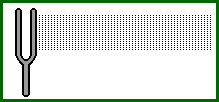A tuning fork serves as a useful illustration of how a vibrating object can produce sound. The fork consists of a handle and two tines. When the tuning fork is hit, the tines begin to vibrate back and forth several hundred times per second. The back and forth vibration of the tines produce disturbances of surrounding air molecules. Often, the vibrations are so fast that they're not visible to the human eye. Experimentally this can be viewed by dipping a humming tuning fork into a cup of water; it will kick up a surprisingly large jet of water.
Tuning fork vibrations in super slow motion:
The speed of a tuning fork's vibrations is known as its frequency, a quantity measured in hertz (Hz), or vibrations per second.The faster a tuning fork's frequency, the shorter the length of the tuning fork tine and the higher the pitch of the note it plays because it has less distance to move. An example: a very high sound may vibrate at 4,000 Hz. and a very low sound vibrate at 28 Hz. It is the same principle as strings on a guitar; a tight string vibrates quickly and a loose string takes longer to shudder back and forth, resulting in a lower tone.

During the vibration, as a tine stretches outward from its usual position, it compresses surrounding air molecules into a small region of space creating a high pressure (compression) region next to the tine. As the tine then moves inward from its usual position, air surrounding the tine expands producing a low pressure (rarefaction) region next to the tine. As the tines continue to vibrate, an alternating pattern of high and low pressure regions are created. These regions are transported through the surrounding air, carrying the sound signal from one location to another forming a sound wave.
The vibration of 440 cycles/sec causes compression and rarefaction of air molecules
generating sound waves.
The "tuning fork" was invented by John Shore, English musician to the royal court in 1711 and had a pitch of A423.5. The numbers underneath the musical notes represent the Hertz (Hz) or cycles per second of the sound wave made when the fork is vibrating.
Standard Pitch or Concert Pitch is a universal frequency or note that all musical instruments are tuned to. Today's standard pitch is A440 or C523.3 and this enables musicians to play instruments together in harmony, without clashing pitches. A tuning fork is normally used to set the pitch. Pitch pipes and electronic tuning forks can also be used, but are not as common

